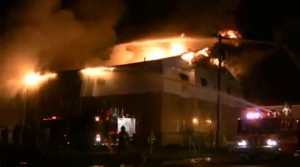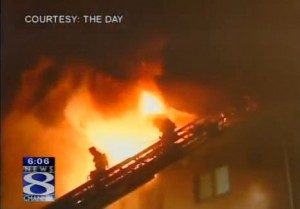Last Tuesday night, approximately fifty people were left homeless by a fire at the Parkside West Apartments in New London, Connecticut, which apparently began on a stove in a 3rd-story apartment. One of the newspaper accounts of the fire investigation reported that the fire marshal stated “in the third-floor apartment where the fire is believed to have started, a weatherstrip prevented the door from closing, allowing smoke to spread.”
Here’s some powerful news coverage from The Day of residents who had escaped from the fire:
 When I read the article, I immediately wondered if the door had spring hinges, because I have seen so many problems with spring hinges that were unable to positively latch the door. I spoke to the fire marshal and confirmed that the door did have spring hinges, and that a door sweep had prevented the door from closing due to the high pile of the carpet. I’m guessing that the sweep was installed for sound attenuation, but so far it’s unknown when or by whom the sweep was installed. The door was replaced in 2004 after another fire in the same unit, and the other apartment doors did not typically have sweeps.
When I read the article, I immediately wondered if the door had spring hinges, because I have seen so many problems with spring hinges that were unable to positively latch the door. I spoke to the fire marshal and confirmed that the door did have spring hinges, and that a door sweep had prevented the door from closing due to the high pile of the carpet. I’m guessing that the sweep was installed for sound attenuation, but so far it’s unknown when or by whom the sweep was installed. The door was replaced in 2004 after another fire in the same unit, and the other apartment doors did not typically have sweeps.
This supports my theory that fire doors are modified improperly and necessary maintenance is not performed because most people aren’t aware of the requirements for fire doors. I was in a building yesterday, where the doors at the top and bottom of the stairs were held open with kick-down stops. I mentioned it to the person I was meeting with and he said, “We didn’t know.” My point, exactly.
When the sweep was installed on the apartment door, there could have been different flooring that didn’t interfere with the closing ability of the door. Even if the sweep did catch on the carpet when it was installed, it could have been seen as a benefit to the resident that the door wasn’t self-closing any more. Self-closing doors can be inconvenient, which is why I could heat my house with the quantity of wood wedges I see.
 There hasn’t been nearly enough education about fire doors – how to identify them and how they’re supposed to work. When the tenant was exiting his apartment during the fire, the smoke and fire could have been at least partially contained by manually closing the door. Maybe he left it open so the fire department could get in and fight the fire, or maybe he understandably ran out of his burning apartment without a backward glance. That’s why the codes require fire doors to be self-closing – so fire protection is not dependent on the actions of a human in a panic.
There hasn’t been nearly enough education about fire doors – how to identify them and how they’re supposed to work. When the tenant was exiting his apartment during the fire, the smoke and fire could have been at least partially contained by manually closing the door. Maybe he left it open so the fire department could get in and fight the fire, or maybe he understandably ran out of his burning apartment without a backward glance. That’s why the codes require fire doors to be self-closing – so fire protection is not dependent on the actions of a human in a panic.
But because the door was open, the third-floor corridor became compromised by smoke so quickly that the other residents could not use the corridor to escape. Many of them had to be rescued by the fire department via ladders, and the time spent on the rescue effort may have delayed initial firefighting efforts. It’s amazing that everyone survived and there were only a few injuries, but the building was heavily damaged and is currently condemned.
The Connecticut State Fire Safety Code refers to the 1999 edition of NFPA 80, which didn’t contain the specific language requiring annual inspection and documentation of fire doors. But imagine if a fire door inspection had been conducted and the deficiences addressed. It could have been as simple as removing the sweep and/or adjusting the spring hinges – not necessarily costly repairs. The insurance claim could be for damage to one unit, rather than a 37-unit building. Fifty people might not be homeless.
Even if a state has not yet adopted the annual inspection requirement, building owners are responsible for ensuring that their fire doors are in good working order. For more information, go to www.firedoorguide.com.
Thank you to Eagle-Eye Wolfskehl for sending me the article that mentioned the weatherstrip.
Images and video courtesy of WTNH and TheDay.com.
You need to login or register to bookmark/favorite this content.






My apartment has spring hinges! They make my door slam SO loud; if only they had used a LCN closer instead!